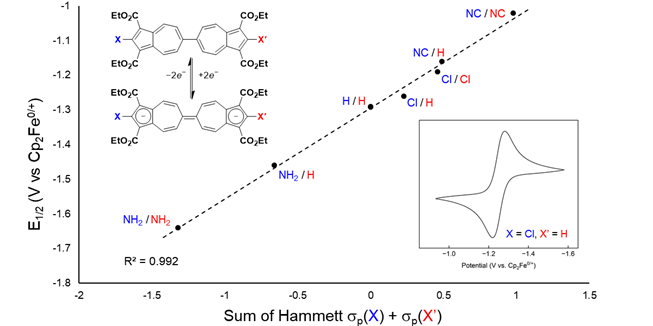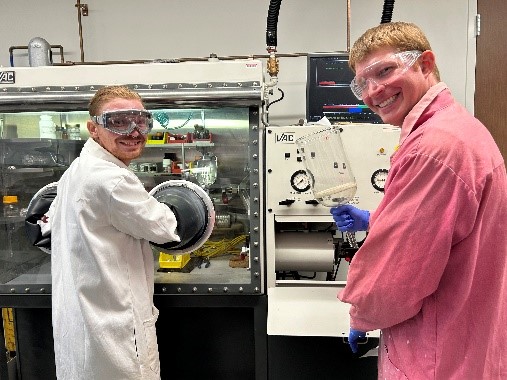Prof. Misha Barybin named June 2024 Sutton Family Research Impact Award recipient

The Department of Chemistry congratulates Professor Mikhail “Misha” Barybin on receiving the June 2024 Sutton Family Research Impact Award!
The Sutton Award is a monthly competition among chemistry faculty. Every month, the Chemistry Department Chair and Associate Chairs review the peer-reviewed papers published by chemistry faculty from the three previous months to select a winner. The recipient receives a $500 cash prize and is featured on the departmental website.
For a full list of winners, visit our Sutton Family Research Impact Award webpage.
Tuning the redox profile of the 6,6’biazulenic platform through functionalization along its molecular axis
By Shaun R. Kelsey, Georgii Griaznov, Andrew D. Spaeth, Daron E. Janzen, Justin T. Douglas, Ward H. Thompson, and Mikhail V. Barybin
Chem. Commun., 2024, 60, 5213
https://doi.org/10.1039/D4CC00656A
Azulene (C10H8) is a nonbenzenoid aromatic hydrocarbon composed of an edge-sharing combination of 5- and 7-membered sp2 carbon rings. Due to their unusual physicochemical characteristics, azulenic and polyazulenic motifs constitute attractive redox addressable, optoelectronic, and conductive molecular building blocks. Recently, 6,6’-biazulene has been emerging as a particularly effective oligoazulenic π-linker. Since the synthesis of the “parent” 6,6’-biazulene by Hanke and Jutz in 1980, access to its derivatives, especially those functionalized along the molecular axis, was quite limited.
In their Chemical Communications article, Drs. Shaun Kelsey, Georgii Griaznov, Andrew Spaeth, Daron Jenzen, Justin Douglas, Ward Thompson, and Misha Barybin introduced facile syntheses of a 2-chloro-6,6’-biazulene and a 2,2’-dichloro-6,6’-biazulene, which are poised to serve as versatile precursors to a variety of linearly functionalized 6,6’-biazulenes. As the centerpiece of this work, the authors demonstrated that the redox profile of the 6,6’-biazulenic scaffold, functionalized along its molecular axis, is quantitatively tunable within an impressively wide window of potentials. This was accomplished by considering, for the first time in the context of azulenic systems, the well documented sp Hammett parameters reflecting the net electronic influence of the substituents (Figure 1). The X-ray crystallographic analysis of 2,2’-dichloro-1,1’,3,3’-tetraethoxycarbonyl-6,6’-biazulene revealed unexpectedly short C-Cl bond distances that, along with other metric changes within the 6,6’-biazulenic core, suggested a non-trivial cycloheptafulvalene-like structural contribution. This discovery offered not only new opportunities to engage the 6,6’-biazulenic architecture as a valuable molecular template in the realm of organic charge transfer and/or conductive materials, but also to explore fundamentally new approaches for pursuing C-Cl multiple bonding.

Figure 1. A plot of the 2e- reduction potential (E1/2) for 2,2’-functionalized 6,6’-biazulenes vs. the combined sp Hammett parameters of the substituents X and X’.

Dr. Georgii Griaznov (left) and Dr. Shaun Kelsey (right)